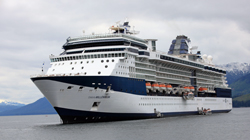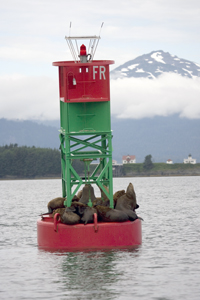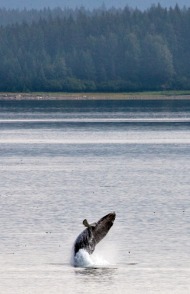
 Millennium Off Icy Strait Point I need to share a bias with you right off the bat. I don't like mega ships and I don't like ships that have crammed so many rock walls, ice skating rinks, shopping malls, surfing experiences and golf courses on to them that they would tire out those riddled with Attention Deficit Disorder. If I want to go to Disneyland I will go to Anaheim - or onto one of their cruise ships. I prefer a ship that feels like a ship. Sure, I like a ship that has its fair share of activities but I also like ones that let me find my own way to pass the time. Now I know that if you are travelling with kids or if you require a thrill a minute, traditional ships may seem a bit quaint but for my money I still want the classic cruise experience. If you are like me, chances are you will really like Millie, as she in known to her guests, because you're made to feel special from the moment you step on board with smiling staff eager to welcome you with a glass of champagne, orange juice or a mimosa. Millie is the first of the "Millennium Class" ships that Celebrity took delivery of in June 2000. She was given a refit in 2009 (new carpets and flat panel TVs were added) and in 2012 she will be "Solsticized" with major changes coming to the Oceanview Cafe & Grill and other parts of the ship to bring some of the popular features of the new "Solstice Class" ships to the "Millennium Class". Once on board, the midship glass elevators will whisk you away to your stateroom where you can freshen up before heading to the welcome buffet in the topside Oceanview Cafe & Grill on Deck 10. After eating, most passengers do a little exploring and, while large, Millie always feels intimate and easy to find your way around. She sports a great deal of wood and brass which gives her the feeling of a ship and not a 300 foot long Las Vegas showroom. The Cosmos Lounge on Deck 11 is often one of the first discoveries that passengers make. Just above the bridge at the bow of the ship, this is the the largest disco/night club on board and during the day serves as a quiet spot to sit and watch the progress of the ship through the panoramic widows stretching the width of the ship. Within hours as arriving on board your luggage will appear in your stateroom and you will have the task of finding places to store all that you have brought with you. Thankfully, Millie's staterooms are equipped with all manner of nooks, crannies, drawers, cupboards, hooks and closets to satisfy the pack horse in all of us. Lifeboat drill usually happens about half an hour before sail away and has changed over the years. Time was you had to wear your life jacket to your assigned muster station (usually in the theatre, lounge or casino), listen to a presentation and then go out onto the open decks to be lined up under the lifeboat that you take you to safety should the need arise. Today, you still assemble at the appropriate muster station but you leave the life jackets in your room and you no longer have to assemble as if on the parade grounds underneath your assigned lifeboat. One of the most exciting events for passengers is the evening meal, taken usually in the Metropolitan Restaurant. This two-storey temple to the gourmand offers early (6:00) and late (8:15) seatings as well as newly introduced "select seating" where passengers can show up at almost anytime for open seating (you don't get to pick your waiter or your table mates though). This new flexibility in the restaurant also marks the end of the evening bistro in the Oceanview Cafe & Grill. Instead there are several short buffet lines available for casual dining in the Cafe in the evening. There is one specialty restaurant on board with a cover charge. The Olympic Restaurant, often regarded as one of the best specialty restaurants afloat, will provide a meal (and service) that is a step above the wonderful treatment guests receive in the main Metropolitan Restaurant. There is a $35.00pp cover charge (additional tipping is suggested but not required) that is actually well worth the cost as food is prepared "a la minute" rather than ahead of time as in the main restaurant, and arrives in perfect unison by "Chef de Rangs", presenting each table guest with their food at precisely the same moment. As you continue to explore the ship, you will discover the Cove Cafe overlooking the mid-ship atrium. The Cova Cafe serves morning pastries and premium coffee and drinks throughout the day, tapas during the day as well as late night snacks, and is a great place to sit and people watch or listen to live music in the evening. Not far away, near the photo shop, you will discover an intimate lounge called Michael's Club which resembles a 19th century gentleman's club complete with dark wood panelling and overstuffed leather chairs. As on all modern cruise ships, there is a shopping area, this one called "The Emporium", where passengers can purchase items ranging in price from a few dollars to a few thousand. Once you have explored the shops on board you may want to drop by the Cyber Cafe which has a number of computers available for passengers to check their emails. There is also a separate computer lab where passengers can receive instruction on the use of popular software packages. Wifi on the ship is limited to several public areas including the centre atrium and surprisingly perhaps, the main dining room. Entertainment includes many different musical groups playing in the various lounges throughout the ship as well as musical reviews and other entertainment in the three-level Celebrity Theater. Millennium also has a convention center which we have used for our photo seminars. This area is made up of a large conference room with theater style seating and smaller boardrooms with seating around conference tables. Celebrity positions itself as a premium cruise line - a step above the mass market offerings of other companies and is able to deliver this "cut above" experience without a huge increase in the price of their cruises. Whether it is the efficiency of the tendering service to shore, the food, bar or coffee service throughout the ship or the offers from smiling staff to take you and your buffet tray to a table, you will be impressed by how well you are treated while on board. If you are interested in seeing more of Millie, take one of the virtual tours offered on the Celebrity web site.You might also want to check out some other reviews on the web.  Minotels are excellent smaller, family-run properties. Find them at http://www.minotel.com Add your tiny tip here.  They are small - you might even say tiny. Twitter tiny - but in a real big blog. We wanted to write simple tips that would take only seconds to read. Comments are open on all T3: Tiny Travel Tips so please feel free to add your own tips! Tip # 1: Eating green apples helps prevent motion sickness. Add your tiny tip here.  Dall's Porpoise At 55 km/hr Off Juneau Back in the day when the earth was still cooling, I purchased my first "real" camera - a Pentax Spotmatic II. I paid the astronomical sum of $214 for it and, in spite of its name, it didn't have a spot meter in it. Thus I learned two valuable lessons - Pentax makes some great cameras and never believe marketing hype! Ever since, cameras have gained more and more complex features that have taken work away from the photographer. Today we use what amounts to a optical computer that needs to boot up, uncover/deploy the lens, determine which orientation the camera is in, establish what light sensitivity to use, recognize the size and format the final picture should be in, if there is a face that can be recognized, where the main subject is, what proper exposure to set and what shutter/aperture combination should be used. All of this happens, in some cases, in well under a second. Having done all this, the camera still needs to be told to focus on the subject, trip the shutter and write the image to the memory card. The space between pressing of the shutter and the final recording of the image is known as "shutter lag" and can be a frustratingly long period of time. Cameras.co.uk has a shuttle lag table that compares a number of cameras. The shuttler lag ranges from 0.18 to 1.68 seconds for a single image and 6.1 to 40.43 seconds for five images. This type of delay, especially at the long end, can be the difference between having more that one photo of a grandchild blowing out birthday candles or a speeding Dall's Porpoise that can travel at 55 km/hr. Old film cameras really were point and shoot (once you had adjusted the necessary settings on the camera) with instantaneous "writing" of an image to film. Today's cameras need to make these settings on the fly and it can really slow down the act of taking a picture. Photographers who want to gain precious time will "preload" the camera by pointing to where the action is (or will be) and softly pressing and holding the shutter release halfway. The camera will focus, charge the image sensor and perform any and all other calculations necessary to get the shot. When the action is just right, or when the subject enters the frame - press the shutter release all the way . The same technique can be used to prefocus on one part of the image and then recompose (move) the camera to get a better photo. This works well with portraits or landscapes where you may not want the subject in the centre. Point the camera directly at that large tree in the landscape (or at uncle Bill), gently press the shutter release part way, then continue to hold and recompose so that you subject is now in another part of the image. In essence, today's cameras are really "point, press and shoot" and if you can use them this way, you will eliminate some of the lag you may be experiencing in your camera. Has shutter lag ever "caught" you at a bad time? Feel free to share your pain in the comment box.  Point Retreat with Buoy and Sea Lions Alaska is a funny place. One day it can be so hot and sunny that you want to dive into your suitcase looking for your Hawaiian shirt and shorts. The next day you could be standing in front of a glacier in the pouring rain wondering why you left your parka at home. The secret, associated with most outdoor activities, is to dress in layers and have sympathy for your extremities as well. This flexibility is really important on an Alaskan cruise because bad weather is often good weather for photgraphers. Jan and I both take fleece vests or sweaters that zip up in the front and then a rainproof outer shell. This protects us in cold and wet conditions and allows us to wear the jacket or sweater separately should it not be as cold or wet. Remember, it may seem quite warm out on your balcony or on the promenade deck, but you may be in a protected area where you can't really gauge weather conditions. Out on a land or sea excursion you may find the weather more extreme than what you experienced on the ship. Jan also brings along a pair of chenille gloves and a headband. Both are small enough to put into a pocket and deploy only if necessary. I have a pair of LowePro gloves that are woven with little non-slip nubs on the fingers. These gloves are good for most of the conditions that Alaska can throw at you during the cruise season. I also take along a short-billed baseball cap (like the ones umpires wear) so that it doesn't interfere with my camera or lens. I used to wear a regular baseball cap backwards, but at my age it makes me look somewhat odd - like I can't dress myself in the morning odd. The trick is to be flexible and expect the weather to change. If you are out on a tour in the early morning you will have to dress more warmly than if you go out in the afternoon. It will probably be cooler if you are heading into the wilderness or onto the water than if you are staying in town shopping. Jan and I went hiking into the rain forest on a particularly warm day. As soon as we passed into the shade of the forest canopy, the temperature dropped significantly and it was great to have those layers of clothing to rely on. Finally, please remember that if the words "flight" or "heli" are in your tour description, chances are you are going somewhere cool - and I mean that in both senses of the word! Try the layered approach and remember, the cruise line will be happy to sell you clothing in the ship's stores if you have miscalculated on your wardrobe choices.  Breaching Whale Spotted From Balcony I usually waffle a bit answering the question "inside or outside" as this is a very personal choice. The whole ship is available to you regardless of the "class" of cabin you invest in, so it might not seem like an advantage to pony up for the extra cost of a balcony. Having said that, an Alaskan itinerary is one of those special trips where a balcony can be a real advantage. Because the scenery is so magnificent and the ship is often close to shore, passengers on Alaskan itineraries tend to be out and about on their balconies for hours. Yes, you can get the same view from any of the open decks, but there are times in the morning, late evening or even as you get ready for dinner that you can take a moment to step out on your balcony for a quick peek at the landscape slipping by. Whale, porpoise, seal or eagle spotting is a popular past time on board and it's great to be steps away for the chance to see these fascinating creatures. The picture to the left was taken in Glacier Bay, and from the balcony of our stateroom. It was pouring rain for most of the journey through Glacier Bay and we didn't want to stand on the open deck getting soaked. Instead, we ordered coffee and tea from room service and sipped our drinks beside the open balcony door. When anything interesting presented itself, we simply stepped out onto the balcony. If you are careful and cruise to Alaska in the spring or fall, you should be able to get a balcony for the cost of an inside cabin during the summer. So, I shall not waffle. If you're thinking about cruising to Alaska, consider a balcony - you will not be disappointed! |
Dougall Photography
Blog Archives
June 2018
Blog Categories
All
|


 RSS Feed
RSS Feed
